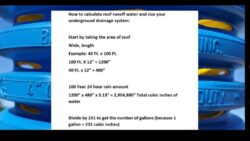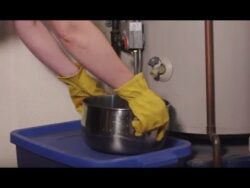How To Fix Water Pressure In Kitchen Sink
Are you tired of dealing with a kitchen sink that barely trickles water out of the faucet? It’s time to put an end to your low water pressure woes and get your sink back to working properly. After all, a fully functional kitchen sink is essential for everyday tasks like washing dishes and preparing food. But where do you start when it comes to fixing water pressure? Don’t worry, we’ve got you covered.
In this article, we’ll guide you through the steps you can take to identify the cause of low water pressure and find the right solution to get your sink working like new again. From cleaning your faucet to upgrading your plumbing, we’ll cover all the options so you can choose the best one for your specific situation. So let’s get started and solve your kitchen sink woes once and for all.
Identify the Cause of Low Water Pressure
Figuring out why the water pressure is low may require some investigation, but it’s important to identify the root cause in order to improve the flow. One of the first things you should do is to check your water supply. If there are any disruptions to the water supply, it can cause a decrease in water pressure. You can check the water supply by contacting your local water supplier to see if there are any known problems in your area.
Another factor that can cause low water pressure is a clogged or damaged pipe. Over time, pipes can become clogged with debris and mineral deposits, which can restrict the flow of water. To determine if this is the issue, you can test the water pressure throughout your home. If the water pressure is low in multiple areas, then it’s likely that the pipes are to blame. In this case, it’s best to contact a plumber to assess the situation and make any necessary repairs.
Lastly, low water pressure can also be caused by a faulty pressure regulator. The pressure regulator is responsible for maintaining consistent water pressure throughout your home. If it’s damaged or not functioning correctly, it can cause a decrease in water pressure. To determine if this is the issue, you can check the pressure regulator by testing the water pressure at different times of the day. If the pressure fluctuates, then it’s likely that the pressure regulator needs to be replaced.
Identifying the cause of low water pressure may take some time, but it’s important to do so in order to improve the flow of water in your home. By checking your water supply, testing water pressure, and assessing the pressure regulator, you can determine the root cause and take the necessary steps to fix the problem.
Clean Your Faucet
Remove Mineral Buildup: To get rid of mineral buildup in your faucet, you can use vinegar. First, unscrew the aerator from the faucet and soak it in a bowl of vinegar for a few hours.
Then, scrub it with an old toothbrush and rinse it thoroughly before reattaching it to the faucet. Replace a Faulty Aerator: If your faucet’s water pressure is still low after cleaning the aerator, it may be time to replace it. To do so, turn off the water supply to the faucet and unscrew the aerator. Take it to a hardware store to find a replacement that fits your faucet, then screw it back on and turn the water supply back on to test the new aerator’s water pressure.
Remove Mineral Buildup
As you scrub away at the stubborn white residue, you can practically hear the minerals grumbling in protest as they are forced to loosen their grip on your faucet. Mineral buildup is a common cause of low water pressure in kitchen sinks. It can also affect the taste and odor of your drinking water.
Preventing mineral buildup is essential to maintain the efficiency of your faucet and improve the quality of your water. To remove mineral buildup, you can use natural cleaners such as vinegar or lemon juice. Mix equal parts of water and vinegar in a spray bottle and apply it to the affected areas. Let it sit for 30 minutes before scrubbing it off with a soft-bristled brush.
For stubborn buildup, you can use a toothbrush or a toothpick to carefully remove the residue. Repeat the process as necessary until the buildup is completely removed. Remember to rinse the faucet thoroughly with water after cleaning to prevent any residual vinegar from affecting the taste of your water.
Replace a Faulty Aerator
You may be frustrated with the weak flow of water from your faucet, but replacing a faulty aerator can quickly and easily improve your experience. The aerator is a small piece screwed onto the end of your faucet that regulates the flow of water and adds air to the stream. Choosing the right aerator for your sink is important, as different models have different flow rates and thread sizes. Make sure to check the manufacturer’s instructions or consult with a plumbing professional to ensure you choose the right aerator for your sink.
Before replacing the aerator, it’s important to troubleshoot any issues you may be having with it. If the water flow is uneven, the aerator may be clogged with mineral buildup or debris.
In this case, try removing the aerator and soaking it in vinegar for a few hours before rinsing it off and replacing it. If the water flow is still weak or nonexistent, the aerator may be faulty and in need of replacement. Simply unscrew the old aerator and replace it with the new one, making sure to tighten it securely. With a new aerator in place, you should notice a significant improvement in water pressure and flow.
Install a Water Pressure Booster
Installing a water pressure booster can significantly improve the performance of your sink and make daily tasks easier. One of the main benefits of installation is that it can increase water pressure and flow rate, providing a stronger stream of water that allows for quicker and more efficient dishwashing and cleaning. It can also make filling up pots and kettles faster, saving you time in the kitchen. When installing a water pressure booster, it’s important to choose the right unit for your needs and ensure it is installed correctly.
Some booster pumps require professional installation, while others can be easily installed by homeowners. Regular maintenance is also important to ensure the booster pump continues to function properly. This includes checking the pressure levels, cleaning or replacing the filters, and checking for leaks. Overall, installing a water pressure booster can be a simple and effective solution to improve your kitchen sink’s water pressure. With proper installation and maintenance, you can enjoy a stronger and more efficient water flow that makes daily tasks in the kitchen a breeze.
Consider Upgrading Your Plumbing
Upgrading your plumbing may be a wise decision if you’re looking to improve the overall efficiency and performance of your kitchen sink. A plumbing upgrade can address multiple issues in one go, such as low water pressure, leaks, and corrosion. It can also reduce the likelihood of future plumbing problems, saving you time and money in the long run.
While the cost of a plumbing upgrade may seem daunting, it’s important to consider the cost comparison between upgrading and constantly repairing your current plumbing system. Upgrading your plumbing may seem like a significant investment upfront, but it can ultimately save you money in the long term. It can also increase the value of your home, making it a worthwhile investment if you plan on selling in the future.
When considering a plumbing upgrade, it’s important to hire a professional plumber to assess your current system and determine the best course of action. They can recommend the most efficient and cost-effective solutions for your specific needs. With the right upgrades, you can enjoy increased water pressure and a more reliable plumbing system for years to come.
Call a Professional Plumber
When you notice a decrease in water pressure in your kitchen sink, it may be time to call a professional plumber. A licensed plumber can diagnose the issue and provide a solution to restore your water pressure. During the service call, expect the plumber to ask questions about the problem, inspect the sink and pipes, and provide a detailed explanation of the repair process.
When to Call a Plumber
If you’re experiencing persistent low water pressure in your sink, it might be time to bring in a professional plumber. While there are some common solutions and DIY fixes that can temporarily improve water pressure, sometimes the underlying problem requires the expertise of a trained plumber.
Here are some signs that it’s time to call in the pros:
- Multiple fixtures are affected: If you’re experiencing low water pressure in multiple areas of your home, such as your shower, toilet, and sink, there could be a larger issue with your plumbing system that requires professional attention.
- Sudden drop in water pressure: If you’ve noticed a sudden and significant drop in water pressure, it could be a sign of a larger issue, such as a leak or blockage in your pipes.
- DIY fixes aren’t working: If you’ve tried common DIY fixes, such as cleaning your faucet aerator or adjusting your water pressure regulator, and you’re still experiencing low water pressure, it’s time to call in a professional plumber.
Remember, while it may be tempting to try and fix the problem yourself, it’s important to prioritize your safety and the integrity of your plumbing system. By calling in a professional plumber, you can ensure that the problem is properly diagnosed and repaired, saving you time, money, and potential headaches in the long run.
What to Expect from a Service Call
If you’ve tried all the common misconceptions and DIY solutions for fixing your kitchen sink’s water pressure, it’s time to call a plumber. But what can you expect from a service call?
First, a plumber will likely ask you some questions about the issue you’re experiencing and any steps you’ve already taken to try to fix it. They may also ask about the age of your plumbing system and any recent changes you’ve made to your home’s water usage.
Once they have a better understanding of the problem, they’ll likely want to take a look at the sink and its surrounding plumbing to diagnose the issue. Depending on the extent of the problem, they may need to use specialized equipment to inspect the pipes and identify any blockages or leaks. Once they’ve identified the source of the problem, they’ll discuss potential solutions with you and provide an estimate for the cost of the repair. With your approval, they’ll then get to work fixing the issue and restoring your sink’s water pressure to its optimal level.
FAQs
How can I tell if low water pressure is affecting only my kitchen sink or my entire house?
If you’re experiencing low water pressure in your kitchen sink, it’s important to determine whether the issue is isolated to just the sink or if it’s affecting your entire home. One way to do this is by conducting a plumbing inspection throughout your house. Check each faucet and showerhead to see if the water pressure is consistently low or if it’s only an issue in your kitchen.
If the low pressure is isolated to your kitchen sink, there are several DIY fixes you can try before calling a plumber. However, if the low pressure is affecting your entire home, it may be a larger issue that requires professional assistance.
Can hard water cause low water pressure in my kitchen sink?
Hard water can definitely cause low water pressure in your kitchen sink. The minerals in hard water can build up in your pipes and fixtures, leading to blockages that restrict water flow. Installing a water softener can help to prevent this issue by removing the minerals from your water. It’s also important to schedule regular plumbing inspections to ensure that your pipes are in good condition and free from any blockages. By taking these steps, you can improve the water pressure in your kitchen sink and enjoy a more efficient and reliable plumbing system.
Will installing a water pressure booster affect the water pressure in other parts of my house?
Installing a water pressure booster can be a great solution to fix low water pressure in your kitchen sink, but it may also affect the water pressure in other parts of your house. The pros of using a booster include increased water pressure, faster water flow, and better cleaning results. However, the cons include higher water bills, potential damage to plumbing systems, and the need for professional installation.
Alternatively, you could try removing mineral buildup from your pipes, adjusting the shut-off valve, or installing a new faucet aerator to improve water pressure.
Consider the pros and cons of boosters and alternative solutions before making a decision.
How much does upgrading plumbing typically cost?
Imagine you’re building a house. You put so much effort into the design and the materials, but what about the plumbing? Upgrading your plumbing may not be as glamorous as choosing tiles for your bathroom, but it’s just as important. Factors like the size of your home, the type of pipes you have, and the complexity of the project can all affect the cost of upgrading plumbing.
On average, the cost can range anywhere from $1,500 to $15,000. However, if you’re handy with DIY projects, there are some options for you to reduce costs by doing some of the work yourself. Just be sure to research and understand the intricacies of plumbing before attempting any major upgrades on your own.
Is it possible for low water pressure to be a sign of a more serious plumbing issue?
If you’re experiencing low water pressure in your home, it could be a sign of a more serious plumbing issue. Common causes of low water pressure include clogged pipes, corroded plumbing, and problems with the main water line. While there are some DIY solutions you can try, such as cleaning out faucet aerators or replacing showerheads, it’s important to know when to call a plumber. If you’ve tried these solutions and are still experiencing low water pressure, or if you notice other signs of plumbing issues like leaks or strange noises, it’s best to call in a professional to diagnose and fix the problem before it worsens.
Congratulations! You’ve successfully learned how to fix your kitchen sink woes by resolving water pressure issues. However, before you start fixing your low water pressure problem, you need to identify its cause. Once you’ve determined what’s causing the issue, you can start cleaning your faucet or installing a water pressure booster. If these don’t work, you may need to upgrade your plumbing or call in a professional plumber.
But wait, before you start tinkering around with your kitchen sink, there’s one crucial thing you need to keep in mind. Depending on the cause of your low water pressure, fixing the problem could be a quick and easy task or a complex and expensive one. Therefore, it’s important to approach the situation with caution, and if you’re not confident with your DIY skills, it’s best to call in a professional plumber. Remember, fixing your kitchen sink woes is essential, but your safety and the integrity of your home’s plumbing system should always come first.





